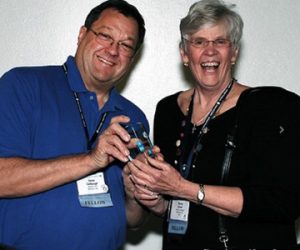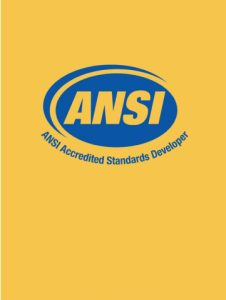Although some radiation exposure is natural in our environment, it is desirable to keep radiation exposure as low as reasonably achievable (ALARA) in an occupational setting. This is accomplished by the techniques of time, distance, and shielding.
Time: The shorter the time in a radiation field, the less the
radiation exposure you will receive. Work quickly and efficiently. Plan
your work before entering the radiation field.
Distance: The farther a person is from a source of radiation,
the lower the radiation dose. Levels decrease by a factor of the square
of the distance. Do not touch radioactive materials. Use remote
handling devices, etc., to move materials to avoid physical contact.
Shielding: Placing a radioactive source behind a massive object provides a barrier that can reduce radiation exposure.
Administrative and Engineering Controls: The use of administrative and engineering controls is essential for keeping radiation exposure ALARA.
Monitoring occupational radiation exposure is a fundamental aspect
of radiation protection. This can be done by measuring radiation fields
with a common handheld instrument such as a Geiger-Mueller counter and, if exposure conditions
are predictable and relatively low (i.e., less than 10 percent of the
regulatory limit), expected exposures can be calculated and documented.
Alternately, regular radiation field survey measurements can be
performed, and personnel dosimeters are issued to workers.
Film Badge: A film badge is one of the earliest devices used
to measure worker exposure to gamma radiation from radium and x rays.
Initially packets of dental x-ray film were worn and developed
periodically to view the degree of darkening. Later special metal
filters were used in a x-ray film holder, with an open window to
provide unattenuated film area for high-energy beta measurement. With
appropriate calibration of exposure versus optical density, these
devices provide an accurate measure of worker external exposure and a
permanent record.
Thermoluminescent Dosimeter (TLD) Badge: The TLD badge is a
personnel monitoring device with special chemical compounds (e.g.,
lithium fluoride) in powder of solid form that retain deposited energy
from radiation exposure. These TL materials emit light when
subsequently heated in a reader. The light is detected by a PMT, and
through calibration the electrical current provides a proportional
measure of radiation exposure. However once read out, the signal from
these devices is erased for the most part. Thus, quality control on
measurements must be to the strictest standards. The National Institute
of Standards and Technology (NIST) has developed a national voluntary
laboratory accreditation program (NAVLAP) for all external dosimetry
(e.g., film, TLD) processors. Cross-checks, reviewed procedures, on-site
inspections, etc., all provide assurance that dosimeter results are of
the highest quality.
Optically Stimulated Luminescence (OSL) Badge: The OSL
dosimeter/reader technology is relatively new and uses a laser to
stimulate an aluminum oxide material that was in the badge for
personnel radiation monitoring of occupationally exposed workers. With
optically stimulated luminescence, a tiny crystal traps and stores
energy from exposure to ionizing radiation fields. The amount of
exposure can be determined by shining a green light on the crystal and
measuring the intensity of the blue light emitted. OSL systems allow
instantaneous readings that can be repeated, as opposed to TLDs which
take 20 or 30 seconds for a one-time-only reading.
Pocket Ionization (Ion) Chamber: This is a sealed
cylindrical air-filled chamber, sometimes called a direct reading dosimeter (DRD) or quartz fiber dosimeter (QFD), with a charged quartz
fiber that can be directly viewed through a built-in microscope. This
filament can be seen against a scale from typically 0 to 200
milliroentgen or 0 to 5 R. Ionizing gamma radiation passing through the
chamber causes a discharge of the device and a deflection of the fiber
upscale. When properly manufactured, maintained, and calibrated, these
devices provide a fairly accurate direct measure of external exposure.
In the late 1980s a thin-walled type was introduced that was more
sensitive to diagnostic-energy x rays. The advantage of these DRDs or
QFDs is instantaneous indication of radiation exposure. However, they
are fragile devices and subject to leakage. Frequent calibration and
leakage checks are recommended, as well as the use of two dosimeters
side by side. Readings that do not reasonably match should be suspect.
Electronic Dosimeters: Electronic dosimeters have been
available since the early 1980s. These devices use energy-compensated
Geiger-Mueller tubes or solid-state detectors with supporting
electronics in a package typically the size of a deck of playing cards.
Features vary with respect to size, ruggedness, user control, display
of accumulated dose and/or dose rate, alarm set point, battery life,
computer interface, etc.
The information posted on this web page is intended as general reference information only. Specific facts and circumstances may affect the applicability of concepts, materials, and information described herein. The information provided is not a substitute for professional advice and should not be relied upon in the absence of such professional advice. To the best of our knowledge, answers are correct at the time they are posted. Be advised that over time, requirements could change, new data could be made available, and Internet links could change, affecting the correctness of the answers. Answers are the professional opinions of the expert responding to each question; they do not necessarily represent the position of the Health Physics Society.






